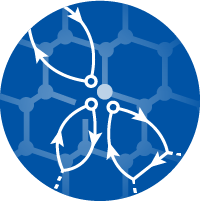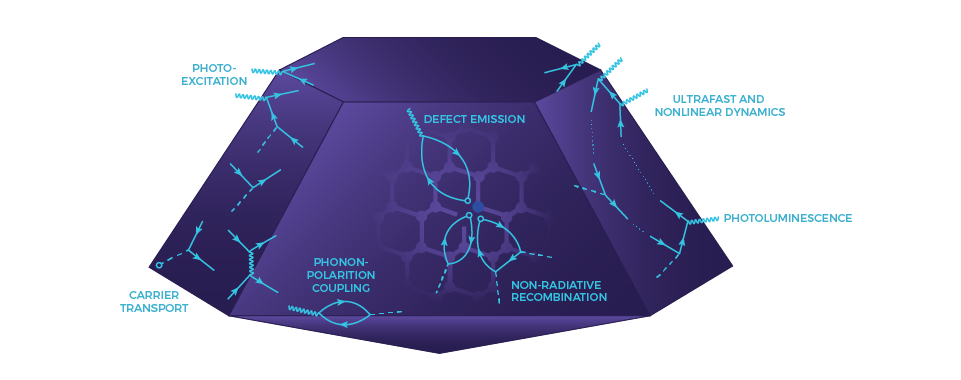

CHALLENGE AND OPPORTUNITY
Excited-state nanophotonics presents a critical challenge and opportunity as it involves competing degrees of freedom and constraints with coupled electrons, photons, and atomic structures. Properties that emerge from correlations between these atomic, electronic and photonic phenomena determine the intermediate length and time scales that can be exploited in applications ranging from quantum information to photocatalysis, and for the design of novel functional materials with tailored optoelectronic properties.
In particular, electron-photon, electron-electron as well as electron-phonon dynamics and far-from-equilibrium transport are critical to describe ultrafast and excited-state optoelectronic interactions in materials. Therefore, we are working on new and efficient theory methods to calculate arbitrary electron-phonon and electron-optical interactions in a Feynman diagram many-body framework integrated with a nonequilibrium carrier transport method.
Understanding and Controlling Collective Excitations of Photons, Phonons, and Electrons.
A major thrust of our research considers the question of creating new states of matter by driving it out of equilibrium. Such novel states of matter can have unexpected — and useful — properties, including surprisingly long coherence times and propagation lengths, allowing the tailoring of quantum properties for given applications. A common approach is to optically drive materials out of equilibrium, but today’s methods for studying optically driven systems are insufficient for revealing underlying mechanisms. Although time-dependent density-functional theory allows us, at least in principle, to study these properties, current approximations are almost exclusively bound to the adiabatic approximation and focus on electronic excitations, neglecting e.g., electron-phonon effects. This approximation limits the applicability of these methods to quantum applications, which requires understanding the coupled dynamics of electronic spins, nuclei, phonons and photons.
To address these problems, we recently introduced a method to predict new states of quantum matter with strong light-matter coupling via a new computational method, quantum electrodynamical density functional theory. This ab initio QED approach involves an exact reformulation of the Schrödinger equation that draws on two prominent theories in physics: quantum electrodynamics and electronic structure theory. This method treats electrons, photons and phonons on the same quantized footing and is, therefore, not restricted to few-level approximations commonly invoked in quantum optics, allowing us to study correlated electron-photon and photon-phonon dynamics, as we have recently demonstrated. Going forward, we intend to use this computational method to provide design principles on optically controlling, manipulating and using the properties of coherent quantum states.
Open Quantum Systems
Efficient control and design of many quantum technologies requires coupling to the control field while minimizing the detrimental effects of the environment. This competition implies that an understanding of a quantum system as open to its environment is critical to accurately understanding quantum processes. One research focus of the NarangLab is developing and improving the efficient treatment of open quantum systems in the presence of complex, non-Markovian environments. Building noise models beyond the Markovian regime has the potential to lead to improvements in quantum computation, communication, and sensing.
Cavity-Correlated and Optically-Excited Non-equilibrium Dynamics from First Principles
Recent Publications:
- Flick, J., & Narang, P. (2018). Cavity-correlated electron-nuclear dynamics from first principles. Physical Review Letters, 121(11), 113002.
- Rivera, N., Flick, J., & Narang, P. (2019). Variational theory of non-relativistic quantum electrodynamics. Physical Review Letters 122, 193603.
- Rivera, N., Christensen, T., & Narang, P. (2019). Phonon polaritonics in two-dimensional materials. Nano Letters, 19, 4, 2653-2660.
- Juraschek, D. M., Narang, P., & Spaldin, N. A. (2019). Phono-magnetic analogs to opto-magnetic effects. Physical Review Research, 2 (4), 043035.
- Juraschek, D. M., Meier, Q. N., & Narang, P. (2020). Parametric excitation of an optically silent Goldstone-like phonon mode. Physical Review Letters 124, 117401.
- Flick, J., & Narang, P. (2020). Ab initio polaritonic potential-energy surfaces for excited-state nanophotonics and polaritonic chemistry. The Journal of Chemical Physics 153, 094116.
- Zhao, B., Guo, C., Garcia, C.A.C., Narang, P., & Fan, S. (2020). Axion-Field-Enabled Nonreciprocal Thermal Radiation in Weyl Semimetals. Nano Letters, 20, 3,1923-1927.
- Juraschek, D.M., Neuman, T. & Narang, P. (2020). Giant phonon-induced effective magnetic fields in 4f paramagnets. arXiv preprint, arXiv:2007.10556, under review.
- Juraschek, D. M., Wang, D. S., & Narang, P. (2021). Sum-frequency excitation of coherent magnons. Physical Review B. 103, 094407.
- Wang, D. S., Neuman, T., Flick, J., & Narang, P. (2021). Light–matter interaction of a molecule in a dissipative cavity from first principles. The Journal of Chemical Physics 154, 104109.
- Juraschek, D.M. & Narang, P. (2021). Highly confined phonon polaritons in monolayers of oxide perovskites. Nano Lett. 2021, 21, 12, 5098–5104.
